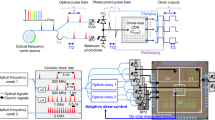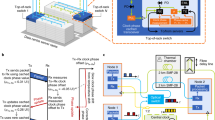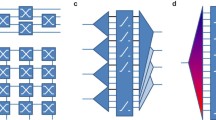Abstract
Techniques for distribution of optical signals, both free space and guided, within electronic systems has been extensively investigated over more than a decade. Particularly at the lower levels of packaging (intra-chip and chip-to-chip), miniaturized optical elements including diffractive optics and micro-refractive optics have received considerable attention. In the case of optical distribution of data, there is the need for a source of optical power and a need for a means of modulating the optical beam to achieve data communications. As the number of optical data interconnections increases, the technical challenges of providing an efficient realization of the optical data interconnections also increases. Among the system signals which might be transmitted optically, clock distribution represents a substantially simplified problem from the perspective of the optical sources required. In particular, a single optical source, modulated to provide the clock signal, replaces the multitude of optical sources/modulators which would be needed for extensive optical data interconnections. Using this single optical clock source, the technical problem reduces largely to splitting of the optical clock beam into a multiplicity of optical clock beams and distribution of the individual clocks to the several portions of the system requiring synchronized clocks. The distribution problem allows exploitation of a wide variety of passive, miniaturized optical elements (with diffractive optics playing a substantial role). This article reviews many of the approaches which have been explored for optical clock distribution, ranging from optical clock distribution within lower levels of the system packaging hierarchy through optical clock distribution among separate boards of a complex system. Although optical clock distribution has not yet seen significant practical application, it is evident that the technical foundation for such clock distribution is well established. As clock rates increase to 1 GHz and higher, the practical advantages of optical clock distribution will also increase, limited primarily by the cost of the optical components used and the manufacturability of an overall electronic system in which optical clock distribution has been selectively inserted.
Similar content being viewed by others
References
Y. Ota, R.C. Miller, S.R. Forrest, D.A. Kaplan, C.W. Seabury, R.B. Huntington, J.G. Johnson, and J.R. Potopowicz, “Twelvechannel individually addressable InGaAs/InP p-i-n photodiode and InGaAsP/InP LED arrays in a compact package,” IEEE J. Lightwave Technol., Vol. 5, No. 4, pp. 1118-1122, 1987.
Y.M. Wong et al., “Technology development of a high-density 32 channel 16 Gb/s optical data link for optical interconnections for the optoelectronic technology consortium (OETC),” IEEE J. Lightwave Technol., Vol. 13, No. 6, pp. 995-1016, 1995.
H. Karstensen, C. Hanke, M. Honsberg, J.-R. Kropp, J. Wieland, M. Blaser, P. Weger, and J. Popp, “Parallel optical interconnection for uncoded data transmission with 1 Gb/sec-per-channel capacity, high dynamic range, and low power consumption,” IEEE J. Lightwave Technol., Vol. 13, No. 6, pp. 1017-1030, 1995.
Special issue: Diffractive Optics: Design, Fabrication, and Applications, Appl. Optics, Vol. 32, No. 14, 1993.
Special issue: Micro-Optics, Optical Eng., Vol. 33, No. 11, pp. 3504-3669, 1994.
S.K. Tewksbury, “Interconnections within microelectronic systems,” in Microelectronic System Interconnections: Performance and Modeling, S.K. Tewksbury (Ed.), IEEE Press, Piscataway, pp. 1-49, 1994.
S.K. Tewksbury (Ed.), Microelectronic System Interconnections: Performance and Modeling, IEEE Press, Piscataway, NJ, 1994.
J.W. Goodman, F.I. Leonberger, S.-Y. Kung, and R.A. Athale, “Optical interconnections for VLSI systems,” Proc. IEEE, Vol. 72, pp. 850-866, 1984.
Special issue: Optical Interconnects, Appl. Opt., Vol. 29, pp. 1067-1177, 1990.
D.B. Clymer and J.W. Goodman, “Optical clock distribution to silicon chips,” Opt. Eng., Vol. 25, pp. 1103-1108, 1986.
L.A. Bergman, W.H. Wu, A.R. Johnston, R. Nixon, S.C. Esener, C.C. Guest, P. Yu, T.J. Brabik, M. Feldman, and S.H. Lee, “Holographic optical interconnects for VLSI,” Opt. Eng., Vol. 25, pp. 1109-1118, 1996.
R.K. Kostuk, L. Wang, and Y.-T. Huang, “Optical clock distribution with holographic optical elements,” in Real-Time Signal Processing XI, J.P. Letellier (Ed.), Proc. SPIE, Vol. 977, pp. 24- 36, 1988.
S. Koh, H.W. Carter, and J.T. Boyd, “Synchronous global clock distribution on multichip modules using optical waveguides,” Optical Eng., Vol. 33, No. 5, pp. 1587-1595, 1994.
A. Himeno, H. Terui, and M. Kobayashi, “Loss measurement and analysis of high-silica reflection bendingwaveguides,” IEEE J. Lightwave Technol., Vol. 6, No. 1, pp. 41-46, 1988.
F. Lin, E.M. Strzelecki, and T. Jannson, “Optical multiplanar VLSI interconnects based on multiplexed waveguide holograms,” Appl. Optics, Vol. 29, No. 8, pp. 1126-1133, 1990.
F. Lin, C. Nugyen, J. Zhu, and B.M. Hendrickson, “Dispersion effects in a single-mode holographic waveguide interconnect system,” Appl. Optics, Vol. 31, No. 32, pp. 6831-6835, 1992.
S.J. Walker, J. Jahns, L. Li, W.M. Mansfield, P. Mulgrew, D.M. Tennant, C.W. Roberts, L.C. West, and N.K. Ailawadi, “Design and fabrication of high-efficiency beam splitters and beam de-flectors for integrated planar micro-optic systems,” Appl. Optics, Vol. 32, No. 14, pp. 2494-2501, 1993.
T. Kubota and M. Takeda, “Array illuminator using grating couplers,” Optics Letts., Vol. 14, No. 12, pp. 651-652, 1989.
J.M. Miller, M.R. Tagizadeh, J. Turunen, and N. Ross, ”Multilevel-grating array generators: Fabrication error analysis and experiments,” Appl. Optics, Vol. 32, No. 14, pp. 2519-2525, 1993.
E. Sidick, A. Knoesen, and J.N. Mait, “Design and rigorous analysis of high-efficiency array generators,” Appl. Optics, Vol. 32, No. 14, pp. 2599-2605, 1993.
S.K. Patra, J. Ma, V.H. Ozguz, and S.H. Lee, “Alignment issues in packaging for free-space optical interconnects,” Optical Eng., Vol. 33, No. 5, pp. 1561-1570, 1994.
J. Schwider, W. Stork, N. Streibl, and R. Völkel, “Possibilities and limitations of space-variant holographic optical elements for switching networks and general interconnects,” Appl. Optics, Vol. 31, No. 35, pp. 7403-7410, 1992.
K.-H. Brenner and F. Sauer, “Diffractive-reflective optical interconnects,” Appl. Optics, Vol. 27, No. 20, pp. 4251-4254, 1988.
E. Bradley, P.K.L. Yu, and A.R. Johnston, “System issues relating to laser diode requirements for VLSI holographic optical interconnections,” Optical Eng., Vol. 28, No. 3, pp. 201-211, 1989.
J. Jahns, Y.H. Lee, C.A. Burrus, Jr., and J. Jewell, “Optical interconnects using top-surface-emitting microlasers and planar optics,” Appl. Optics, Vol. 31, No. 5, pp. 592-597, 1992.
G.P. Behrmann and J.P. Bowen, “Influence of temperature on diffractive lens performance,” Appl. Optics, Vol. 32, No. 14, pp. 2483-2489, 1993.
J. Schwider, “Achromatic design of holographic optical interconnects,” Optical Eng., Vol. 35, No. 3, pp. 826-831, 1996.
T.M. Shen, “Timing jitter in semiconductor lasers under pseudorandom word modulation,” IEEE J. Lightwave Technol., Vol. 7, pp. 1394-1399, 1989.
A. Weber, W. Ronghan, E. Bottcher, M. Schell, and D. Bimberg, ”Measurement and simulation of the turn-on delay time jitter in gain-switched semiconductor lasers,” IEEE J. Quantum Electronics, Vol. 28, pp. 441-446, 1992.
V.N. Morozov and W. Thomas Cathey, “Practical speed limits of free-space global holographic interconnects: Time skew, jitter and turn-on delay,” Appl. Optics, Vol. 33, No. 8, pp. 1380-1390, 1994.
P. Cinato and K.C. Young, Jr., “Optical interconnections within multichip modules,” Optical Eng., Vol. 32, No. 4, pp. 852-860, 1993.
S.K. Tewksbury, Wafer Level System Integration: Implementation Issues, Kluwer Academic Publishers, Boston, 1989.
S.K. Tewksbury and L.A. Hornak, “Multichip modules: A platform for optical interconnections within microelectronic systems,” Int. J. Optoelectronics, Devices, and Technologies, MITA Press, Japan, Vol. 9, No. 1, pp. 55-80, 1994.
L.A. Hornak and S.K. Tewksbury, “On the feasibility of throughwafer optical interconnects for hybrid wafer-scale integrated architectures,” IEEE Trans. Elect. Dev., Vol. 34, No. 7, pp. 1557- 1563, 1987.
D.S. Wills, W.S. Lacy, C. Camperi-Ginestet, B. Buchanan, H.H. Cat, S. Wildinson, M. Lee, N.M. Jokerst, and M.A. Brooke, “A three-dimensional high-throughput architecture using throughwafer optical interconnect,” IEEE J. Lightwave Technol.,Vol. 13, No. 6, pp. 1085-1092, 1995.
M.J. Wale et al., “A new self-aligned technique for the assembly of integrated optical devices with optical fiber and electronic interfaces,” Proc. ICIC '89, paper ThA19-7, p. 368, 1989.
M.J. Goodwin, A.J. Mosely, M.G. Kearly, R.C. Morris, D.J. Groves-Kirkby, J. Thompson, R.C. Goodfellow, and I. Bennion, “Optoelectronic component arrays for optical interconnection of circuits and systems,” IEEE J. Lightwave Technol., Vol. 9, No. 12, pp. 1639-1645, 1991.
R. Selvaraj, H.T. Lin, and J.F. McDonald, “Integrated optical waveguides in polyimide for wafer scale integration,” IEEE J. Lightwave Technol., Vol. 6, pp. 1034-1037, 1988.
J.C. Lyke, R. Wojnarowski, G.A. Forman, E. Bernard, R. Saia, and B. Gorowitz, “Three dimensional patterned overlay high density interconnect (HDI) technology,” Journal of Microelectronic Systems Integration, Vol. 1, No. 2, pp. 99-141, 1993.
R.S. Beech and A.K. Ghosh, “Optimization of alignability in integrated planar-optical interconnect packages,” Appl. Optics, Vol. 32, No. 29, pp. 5741-5749, 1993.
J. Jahns and R.A. Brumback, “Integrated-optical split-and-shift module based on planar optics,” Opt. Commun.,Vol. 76, pp. 318- 323, 1990.
F. Sauer, “Fabrication of diffractive-reflective optical interconnects for infrared operation based on total internal reflection,” Appl. Optics, Vol. 28, pp. 386-388, 1989.
J. Jahns and A. Huang, “Planar integration of free-space optical components,” Appl. Optics, Vol. 28, pp. 1602-1605, 1989.
H.J. Haumann, H. Kobolla, F. Sauer, J. Schmidt, J. Schwider, W. Stork, N. Streibl, and R. Völkel, “Optoelectronic interconnections based on a light-guiding plate with holographic coupling elements,” Opt. Eng., Vol. 30, pp. 1620-1623, 1991.
L.A. Hornak, S.K. Tewksbury, J.C. Barr, W.D. Cox, and K.S. Brown, “Optical interconnections and cryoelectronics: Complimentary enabling technologies for emerging mainstream systems,” SPIE Photonics West Symposium, Optical Interconnections III Conference, San Jose, CA, Feb. 1995.
J.W. Parker, “Optical interconnection for advanced processor systems: A review of the ESPRIT II OLIVES program,” IEEE J. Lightwave Technol., Vol. 9, pp. 1764-1773, 1991.
Y. Yamanaka, K. Yoshihara, I. Ogura, T. Numai, K. Kasahara, and Y. Ono, “Free-space optical bus using cascaded verticalto-surface transmission electrophotonic devices,” Appl. Optics, Vol. 31, No. 23, pp. 4676-4681, 1992.
A. Guha, J. Briston, C. Sullivan, and A. Husain, “Optical interconnects for massively parallel architectures,” Appl. Optics, Vol. 29, pp. 1077-1093, 1990.
K. Kasahara, Y. Tahiro, N. Hamao, M. Sugimoto, and T. Yanese, “Double heterostructure optoelectronic switch as a dynamic memory with low-power consumption,” Appl. Phys. Lett., Vol. 52, pp. 679-681, 1988.
K. Rastani and W.M. Hubbard, “Alignment and fabrication tolerances of planar gratings for board-to-board optical interconnects,” Appl. Optics, Vol. 31, pp. 4863-4870, 1992.
“High-speed optical interconnects for digital systems,” Lincoln Labs. Journal, Vol. 4, pp. 31-43, 1991.
D.Z. Tsang, “Free-space board-to-board optical interconnections” in Optical Enhancements to Computing Technology, J.A. Heff (Ed.), SPIE Vol. 1563, pp. 66-71, 1991.
D.Z. Tsang and T.J. Goblick, “Free-space optical interconnection technology in parallel processing systems,” Optical Eng., Vol. 33, No. 5, pp. 1524-1531, 1994.
C.T. Sullivan, “Optical waveguide circuits for printed wire-board interconnections,” Proc. SPIE, Optoelectronic Materials, Devices and Packaging, Vol. 994, p. 92, 1988.
R.C. Kim, E. Chen, and F. Lin, “An optical holographic backplane interconnect system,” IEEE J. Lightwave Technol., Vol. 9, pp. 1650-1656, 1991.
S. Natarajan, C. Zhao, and R.T. Chen, “Bi-directional optical backplane bus for general purpose multiprocessor board-toboard optoelectronic interconnects,” IEEE J. Lightwave Technol., Vol. 13, No. 6, pp. 1031-1040, 1995.
R.K. Kostuk, J.-H. Yeh, and M. Fink, “Distributed optical data bus for board-level interconnections,” Appl. Optics, Vol. 32, No. 26, pp. 5010-5021, 1993.
R.K. Kostuk, “Simulation of board-level free-space optical interconnects for electronic processing,” Appl. Optics, Vol. 31, No. 14, pp. 2438-2445, 1992.
B. Dheodt, P. De Dobbalaer, J. Blondelle, P. Van Daile, P. Demester, and R. Baets, “Monolithic integration of diffractive lenses with LED arrays for board-to-board free space optical interconnect,” IEEE J. Lightwave Technol., Vol. 13, No. 6, pp. 1065-1073, 1995.
R.S. Beech and A.K. Ghosh, “Optimization of alignability in integrated planar-optical interconnect packages,” Appl. Optics, Vol. 32, No. 29, pp. 5741-5749, 1993.
Author information
Authors and Affiliations
Rights and permissions
About this article
Cite this article
Tewksbury, S.K., Hornak, L.A. Optical Clock Distribution in Electronic Systems. The Journal of VLSI Signal Processing-Systems for Signal, Image, and Video Technology 16, 225–246 (1997). https://doi.org/10.1023/A:1007951426624
Published:
Issue Date:
DOI: https://doi.org/10.1023/A:1007951426624




